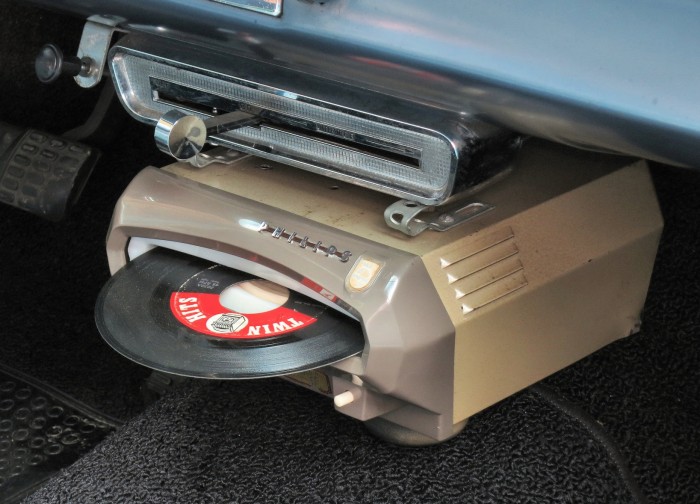Spinning vinyl while cruising the interstate
Posted on May 18, 2018 in Featured | 2 comments

I spotted this in-car record player mounted under the instrument panel of a late-1950s Dodge this past weekend at a car show, and it just stopped me in my tracks. Though Chrysler had its optional Highway Hi-Fi beginning in 1956, this unit is instead an aftermarket Philips Norelco Auto Mignon that was produced a few years later.
Unlike the early Chrysler system developed by CBS that only accepted proprietary 7-inch, 16 2/3 rpm records, this Philips unit would play common 45s like the RCA Victor Victrola that Chrysler offered as an option in 1960.
Those of us who can remember how simply walking across the bedroom floor while a record was playing on a home stereo could make it skip, I’m sure are wondering how it could work in car without destroying the vinyl by skipping at every pavement pebble, brake application and change of direction. The philosophy was to apply more pressure at the stylus and suspend the unit on springs within its housing, so it could sort of float.
It may sound iffy, but it worked, at least according to Consumer Reports, when the magazine tested a few models in the early 1960s. The Auto Mignon and the Victrola were praised for not skipping even in adverse road conditions. The RCA model was also recognized for the fact that it held and would play 14 45s in a row without the driver needing to fiddle with it or change records.

The technology was imperfect, however. Concerns were raised regarding premature wear due to the extra pressure on the stylus. The RCA played a bit too fast and the Philips only played one record at a time, and then it had to be manually changed—on average every 3 to 4 minutes. It also only held one record, offering no storage area for others.
As you can see, it is less than a perfect entertainment situation, not to mention the fact that having 45s in the car and trying to avoid scratching them was not easy. Even when stored properly, any summer day invited heat warpage of the vinyl. Nevertheless, these onboard record players were the first steps toward the driver being able to choose and play the songs that he or she enjoyed instead of what the radio disc jockey chose.
It’s interesting to consider the effort that was required to provide that choice back in the late 1950s and early 1960s when compared to simply plugging an MP3 player into a new car and having instant access to our entire personal music library and being able to play it in digital stereo. Of course we shouldn’t discount the advances that came in between, like the 4-track and 8-track cartridges, cassettes, and cds.





.gif)


My wife had a Norelco 45 rpm player in her 1957 Chevy convertible back in the early 60’s. It worked fine most of the time. Only skipped on real hard bumps.
She bought another online a few years ago with a plan to put it in her 57 Chevy convertible that is undergoing restoration.
Back in ’66 a friend had a Norelco in his ’57 Plymouth. worked pretty well but turned all the labels black. I guess whatever held the record in place touched the label. Hence we sometimes had to guess what the record was.